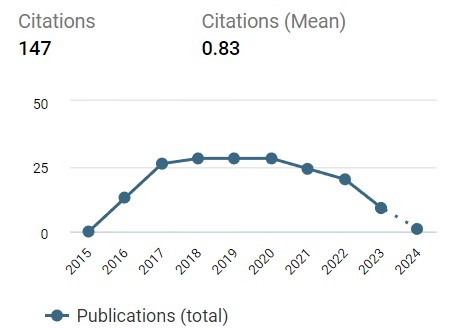Pengembangan E-Modul Pembelajaran CAD Berbasis Android untuk Meningkatkan Hasil Belajar Menggambar 3D
DOI:
https://doi.org/10.21831/dinamika.v5i2.34788Keywords:
android-based CAD, e-module, 3D drawing, learning outcomes, CAD berbasis android, e-modul, gambar 3D, hasil belajarAbstract
This study aims to produce an android-based e-module on CAD that has quality (feasible, effective, and practical) in improving student learning outcomes. The method used is the Research and Development (R&D) approach, which consists of preliminary studies, development, and testing by experts and practitioners to ensure that the e-module meets the requirements (feasible and practical) as a learning media. Limited trials were conducted through a true-experimental design with a pretest-posttest control group design. This experiment was conducted to test the effectiveness of e-modules during the learning process. The analysis used includes a validity test, reliability test, normality test, homogeneity test, independent-sample t-test, and N-Gain test. The results of the study found that the e-module products that met the standards of material and media feasibility based on expert judgment and e-modules were very practical and effective to improve learning outcomes.
Tujuan penelitian ini adalah untuk menghasilkan e-modul pembelajaran CAD berbasis android yang memiliki kualitas (layak, efektif dan praktis) yang dapat membantu meningkatkan hasil belajar peserta didik. Metode yang digunakan adalah pendekatan Research and Development (R&D) yang terdiri dari studi pendahuluan, pengembangan dan pengujian oleh beberapa ahli dan praktisi untuk memastikan bahwa e-modul tersebut memenuhi syarat (layak dan praktis) sebagai media pembelajaran. Uji coba terbatas dilakukan melalui true-eksperimental design dengan pretest-posttest control group design. Eksperimen ini dilakukan untuk menguji efektivitas e-modul selama proses pembelajaran. Analisis yang digunakan meliputi uji validitas, uji reliabilitas, uji normalitas, uji homogenitas, dan uji independent sample t test serta uji N-Gain. Hasil penelitian mendapatkan produk e-modul yang telah memenuhi standar kelayakan materi dan media berdasarkan penilaian ahli serta e-modul sangat praktis dan efektif untuk meningkatkan hasil belajar.
References
Alias, N. dan S. Siraj. 2012. Effectiveness of Isman instructional design model in developing physics module based on learning style and appropriate technology. Procedia-Social and Behavioral Sciences 64: 12-17.
Astra, I. M., H. Nasbey, dan A. Nugraha. 2015. Development of an Android Application in the Form of a Simulation Lab as Learning Media for Senior High School Students. Eurasia Journal of Mathemetics, Science & Technology Education 11(5): 1081-1088.
Calimag, J.N., P. A. G. Miguel, R. S. Conde, dan L. B. Aquino. 2014. Ubiquitous Learning Environment Using Android Mobile Application. International Journal of Research in Engineering & Technology 2(2):119-128.
Fajri, S. N. dan M. Khumaedi. 2016. Penerapan Modul Pembelajaran Solidworks Untuk Meningkatkan Kompetensi Membuat Model 3D. Jurnal Pendidikan Teknik Mesin 16(1): 43-47.
Ferdousi, B. dan J. Bari. 2015. Infusing mobile technology into undergraduate courses for effective learning. Procedia-Social and Behavioral Sciences 176: 307-311.
Hake, R. R. 1998. Interactive-engagement versus traditional methods: A six-thousand-student survey of mechanics test data for introductory physics courses. American journal of Physics 66(1): 64-74.
Hartoyo. 2009. Upaya Meningkatkan Prestasi Melalui Pembelajaran Dengan Modul Berbasis Kompetensi. Jurnal Pendidikan Teknologi dan Kejuruan 18(1): 61-84.
Kemendikbud, 2017. Panduan Praktis Penyusunan E-Modul Pembelajaran. Direktorat Pembinaan SMA, Ditjen Pendidikan Dasar dan Menengah. Jakarta : DPSMA.
Khasanah, A. N., S. Widoretno, dan S. Sajidan. 2017. Effectiveness of Critical Thinking Indicator-Based Module in Empowering Student's Learning Outcome in Respiratory System Study Material. Jurnal Pendidikan IPA Indonesia 6(1): 187-195.
Majid, M. S. Z. B. A., M. M. B. A. Ali, A. A. B. A. Rahim, dan N. Y. B. Khamis. 2012. The Development of Technical English Multimedia Interactive Module to Enhance Student Centered Learning (SCL). Procedia-Social and Behavioral Sciences 67: 345-348.
Martono, K. T. dan O. D. Nurhayati. 2014. Implementation of Android Based Mobile Learning Application As A Flexible Learning Media. International Journal of Computer Science Issues (IJCSI) 11(3): 168-174.
Matanluk, O., B. Mohammad, D. N. A. Kiflee, dan M. Imbug. 2013. The Effectiveness Of Using Teaching Module Based On Radical Constructivism Toward Students Learning Process. Procedia-Social and Behavioral Sciences 90: 607-615.
Wardani, S., L. Lindawati, dan S. B. W. Kusuma. 2017. The Development of Inquiry by Using Android-System-Based Chemistry Board Game to Improve Learning Outcome and Critical Thinking Ability. Jurnal Pendidikan IPA Indonesia 6(2): 196-205.
Wibawa, S. C. dan S. Schulte. 2015. Beauty Media Learning Using Android Mobile Phone. International Journal of Innovative Research in Advanced Engineering 11(2): 20-26.
Wijaya, E. Y., D. A. Sudjimat, dan A. Nyoto. 2016. Transformasi Pendidikan Abad 21 Sebagai Tuntutan Pengembangan Sumber Daya Manusia Di Era Global. Prosiding Seminar Nasional Pendidikan Matematika. Universitas Kanjuruhan Malang. Malang. 263-278.
Yudiono, H., Soesanto dan Haryono. 2018. An Industrial Competency-Based Curriculum Alignment Model. World Transactions on Engineering and Technology Education 16(1):18-22.





